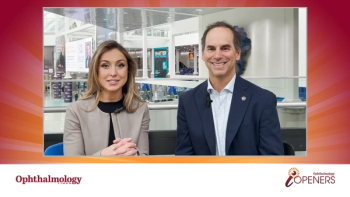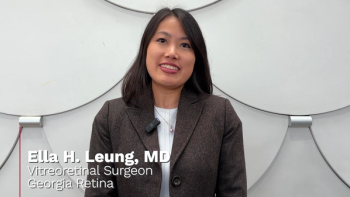
Securing reimbursement for CXL
Kathryn M. Hatch, MD, explains how achieving broader coverage and fair reimbursement of CXL will make the procedure more available to patients- many of whom cannot afford it otherwise.
Editor’s Note:CMS has recently issued a preliminary decision to establish a new J code specific to Photrexa Viscous and Photrexa (Avedro), which should streamline the claims submission process. This preliminary decision is expected to be finalized in November 2018; and, if finalized, effective Jan. 2019. For now, current billing practice would remain unchanged and a miscellaneous J code (J3490), as suggested by the American Academy of Ophthalmology, remains an option to bill for Photrexa until CMS’ decision is finalized.
I have been performing corneal collagen crosslinking (CXL) on an investigational basis since 2011, and as a commercial procedure since FDA approval of the drug/device combination product of riboflavin 5’-phosphate in 20% dextran ophthalmic solution, (Photrexa Viscous), riboflavin 5’-phosphate ophthalmic solution (Photrexa), and the “epi-off” CXL treatment (KXL System) (all from Avedro) in 2016.
My practice, a satellite office of Massachusetts Eye and Ear, receives many referrals of patients with progressive keratoconus or post-LASIK ectasia. We perform CXL on as many as five to 10 patients per week. I have treated patients across a range of ages, but the majority of candidates for CXL-and those most vulnerable to progression-are teens and young adults. In summer 2017, our largest commercial insurer, Blue Cross Blue Shield of Massachusetts (BCBS), issued a positive coverage decision for CXL. Having CXL designated as a covered service was encouraging for all who consider it to be standard of care.
However, there was another hurdle to clear. As is typical with new procedures, BCBS had not yet established a payment amount for the procedure. Our practice was dismayed to learn that the first two dozen claims it submitted were reimbursed at very low levels. CXL costs involve both the drug formulations as well as the physician charges for the in-office procedure. The drugs-which the practice or facility purchases up front-are billed under a J3490 code and reimbursed essentially as a pass-through cost.
The problem was with the office procedure code (0402T), which was reimbursed at a suboptimal level. FIGHTING FOR MORE My intention was not to become an advocate for insurance reimbursement. However, I believed so strongly that this procedure-the only proven therapeutic treatment for progressive keratoconus-should be covered and fairly reimbursed that fighting back seemed the only reasonable option.
I worked with the billing department at Massachusetts Eye and Ear and the CXL drug/ device manufacturer to convince BCBS that higher payments for CXL were justified. We learned the insurer had taken a “treatlike” approach, comparing CXL with treatment for the skin condition, vitiligo, and using that as the basis for its payment decisions.
Through months of correspondence and a teleconference with the insurer, we worked to demonstrate this was not an apt comparison. Keratoconus and ectasia are progressive conditions that can lead to significant vision loss and the need for corneal transplants. CXL limits progression and can prevent higher-cost transplants in the future, a huge consideration for these young patients. We argued that it made financial sense for the insurer to reimburse physicians more appropriately for this one-time, medically necessary procedure. BCBS listened, and eventually amended the payment policy. It now reimburses close to four times the amount we were initially paid for CXL.
The battle continues with other insurance companies but physicians across the country are finding similar success-with more than 30 insurance carriers now covering CXL, up from three at the beginning of 2017. For physicians who are spending money on the treatment device and on the outlay for riboflavin, the initial payment uncertainty can feel risky-but we know offering this treatment to patients is the right thing to do. Achieving broader coverage and fair reimbursement of CXL will make the procedure more available to patients-many of whom cannot afford it otherwise.
I have had patients who delayed treatment because of the cost and ended up with much worse vision due to progression. Others have had to make tough financial decisions when a child needs an important treatment that is not fully covered by insurance. In addition to providing appropriate care for patients, performing CXL now also positions the practice to take advantage of developments in the pipeline as they become approved in the United States. Treatments currently being studied include the “epi-on” technique, which is in clinical trials in the United States, as well as customized CXL and refractive applications for the treatment of myopia and presbyopia being studied outside the United States.
Certainly, there will continue to be some bumps in the road when it comes to reimbursement and coverage. I am confident that CXL will eventually be widely regarded by insurance carriers as the medically necessary service it is. It is hoped that will allow clinicians to focus on the next challenge: The development of effective screening programs to identify keratoconus patients earlier in the course of their disease, before they lose vision.
Kathyrn M. Hatch, MD
P: 781/890-1023 E: [email protected]
Dr. Hatch is director of the Refractive Surgery Service and site director for the Waltham offi ce of Massachusetts Eye and Ear. Dr. Hatch is a consultant for Avedro.
Disclosures:
Kathyrn M. Hatch, MD
P: 781/890-1023 E: [email protected]
Dr. Hatch is director of the Refractive Surgery Service and site director for the Waltham offi ce of Massachusetts Eye and Ear. Dr. Hatch is a consultant for Avedro.
Newsletter
Don’t miss out—get Ophthalmology Times updates on the latest clinical advancements and expert interviews, straight to your inbox.













































.png)


